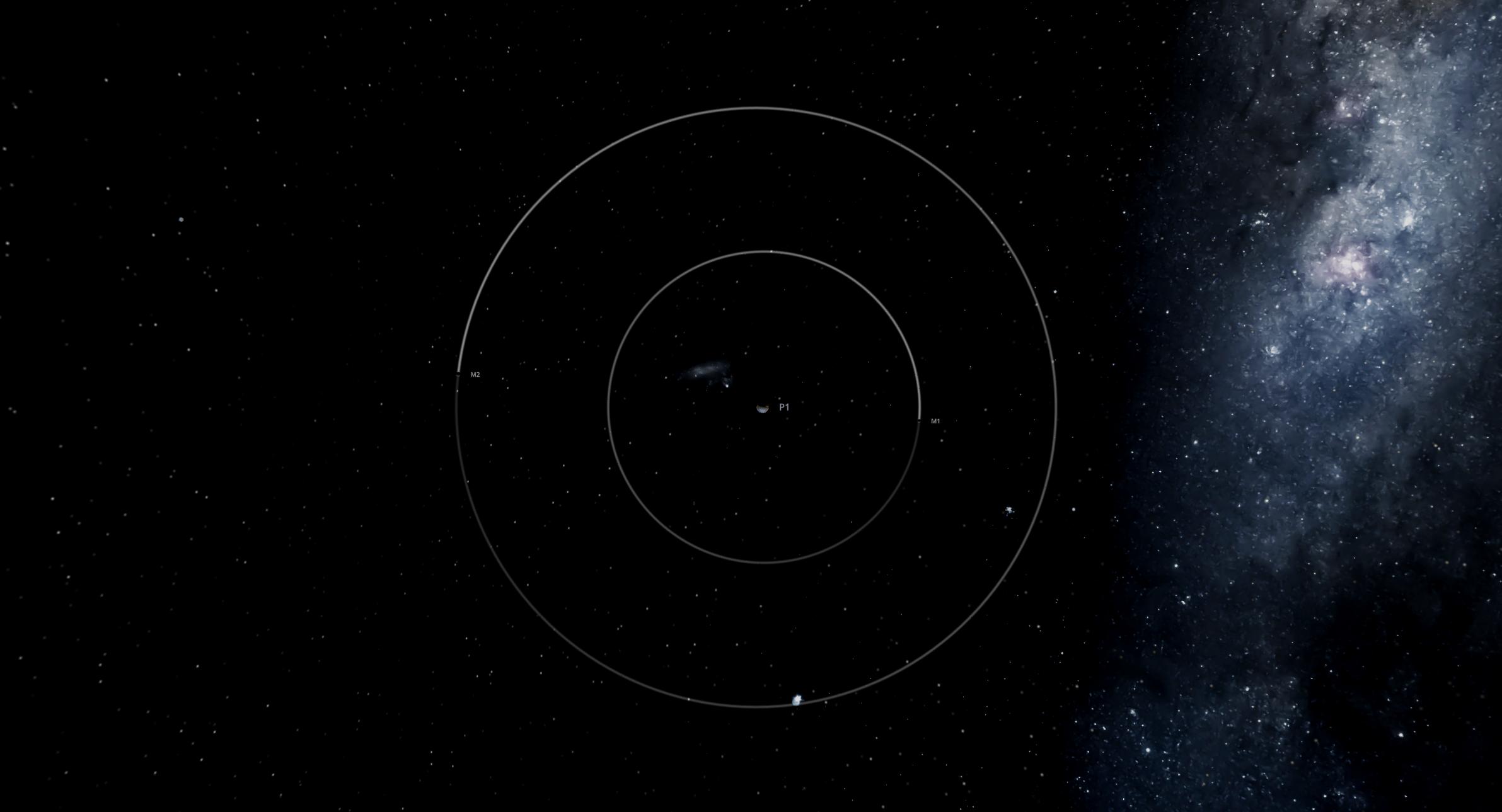So, obviously this depends a lot on the initial conditions. For simplicity, lets assume the ideal case of two moons, one half as massive as the other, on circular orbits around a central body. Like this;
Now there are a few * to this. First of all, Universe sandbox 2 uses classical mechanics for its simulations. However, outside of extreme cases this is fine. All we really care about is that the simulation is not done on point masses, but instead takes the physical size of the body into account. As many orbits appear stable for point masses, but really are not.
Thankfully, we can actually ignore a lot of variables. Like for instance density or composition. Only the final mass and radius matters. And of those two, the mass is more important.
For now, lets just see how this specific setup works out
$M_{P1} = 1$
$M_{M1} = 0.025 M_{P1}$
$M_{M2} = 0.05 M_{P1}$
$d_{P1-M1} = 150000 km$
$d_{P1-M2} = 300000 km$
Now, if the need comes up, i can redo this using GR but i dont want to.

This is the state after 120 Years. As you can see the orbit of M2 has become elliptical and both bodies experience significant orbital orbital precession. The elliptical nature is important, because it means the system is losing energy as a whole.

And after ~250 years, M2 got kicked out. If we think about this, it makes sense. M1, while having a lower mass, has a lot more Energy in its orbit as it is faster and deeper inside of P1 gravity well. So it takes a lot more energy to change its orbit. Notice, even after M2 got kicked out, M1´s orbit is elliptical but i mean the Percenter distance is ~120000 km while the Apocenter is 200000. Sure, the orbit is not circular but its fine.
Where as M2 experienced Apogee´s around 0.006 AU (~ 1 million kilometers) at the end. Orbits with such high eccentricity are not stable as there is a huge energy imbalance. The velocity of the orbiting object constantly changes. And this energy has to come from somewhere.
But ok, lets run this again but change the fractions. So that M1 has 0.01P1 and M2 has 0.005P1. Also lets bump up the distance to 500000 km for M2. Once again, perfectly circular orbits 3...2...1 go;
So after 5300 years M2 has an orbital period of 10 years, with a minimal distance of 0.02 AU and a maxima of 0.07 AU. You have to keep in mind, the fact the orbit is so elliptical is completely unrealistic if there is literally any other object in a solar system. M2 is only still orbiting because nothing else tugs on it. Even then, now (6000 Years) the orbit has a period of 13 years. The energy M2 loses each time it passes is insane.
7300 years, and we have an orbital period of 34 years. Again, not realistic if your solar system has any other bodies.
And at long last, 8700 years into the journey M2 is adios.
Answer Section
As per your question, i think the answer is No.
While these simulations have many flaws, non of them are to your advantage. We looked at very idealized situations which would not occur anywhere. Be that perfectly circular orbits, no other bodies to interact with etc. Kind of the only thing you can look at for help is numerical precision, since the more precise your simulation is the more stable it tends to be. Especially in cartesian space and simple math. However, i dont think the results are unreasonable. And they paint a picture in which these configurations are just not stable. At least in the timeframe you want. I mean, config 2 was in essence Earths moon and half of Earths moon orbiting, and it worked for less than 10000 years. Plus, for most of that runtime M2 was so far away you would have not really seen it.
You might want to look at a different configuration. Binary planets, with a distant moon. If you have two Earth sized planets orbiting, their orbit is going to be pretty circular. A third body will still not be stable, but it will be more stable than what we have seen here. Because the gravitational center is more or less constant. Tidal forces are still different, but i would bet money on a Binary with a moon being stable for 100.000 years...
But this might not be what you aim for, since this requires a close binary with a distant moon.



